HEALTH
Parachute Health: Redefining Efficiency in Care
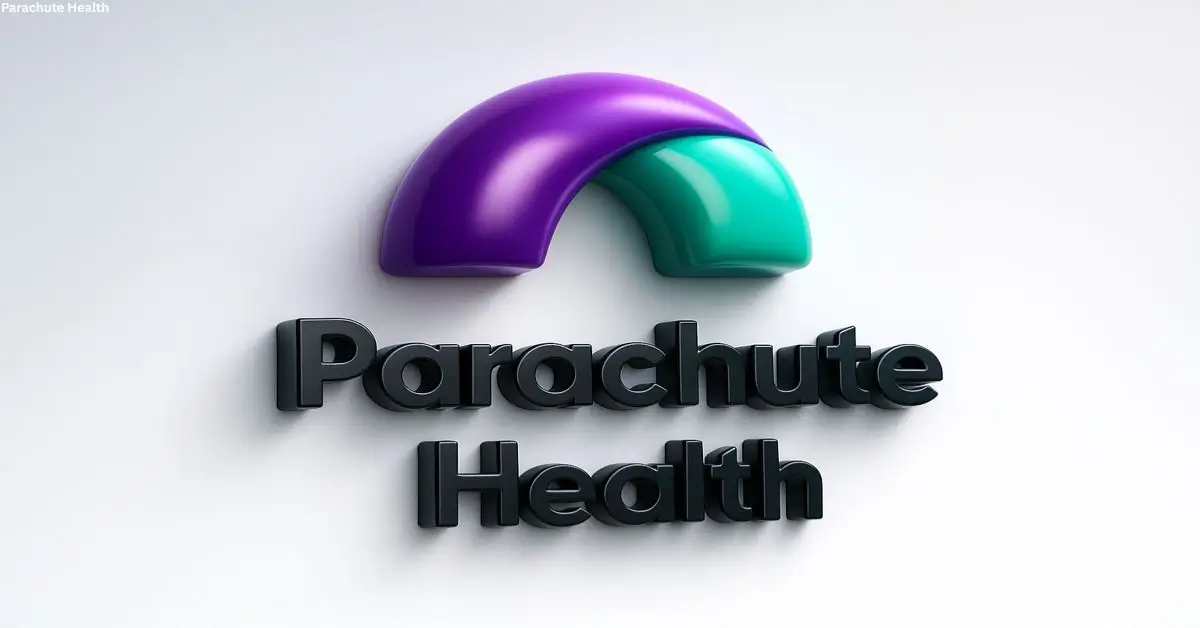
In today’s evolving medical industry, Parachute Health is setting a new standard in how durable medical equipment (DME) is ordered and delivered. With a mission to modernize healthcare workflows, this digital platform eliminates the inefficiencies of traditional methods and ensures patients receive care faster, with greater accuracy and less administrative burden.
The Rise of Digital Efficiency in Medical Equipment Ordering
The healthcare ecosystem has long struggled with outdated processes, especially when it comes to DME. Faxed forms, missed signatures, and compliance issues have historically delayed patient care. Enter solutions like Parachute Health, which revolutionize this complex system by automating order workflows and facilitating real-time collaboration among providers, case managers, and suppliers.
This digital transformation isn’t just about making life easier for clinicians. It’s about improving patient outcomes, enhancing regulatory compliance, and maximizing operational efficiency.
How the Platform Works
Built as a cloud-based ePrescribing platform, Parachute Health allows healthcare providers to place and manage DME orders entirely online. Instead of relying on manual forms, users select necessary equipment and submit orders through a secure digital workflow. The system includes built-in logic to flag missing information, ensure compliance, and facilitate fast processing.
Real-Time Documentation Checks
The platform verifies that all necessary documents are in place before an order is sent to a supplier. This reduces the likelihood of denials, rework, or patient delays.
Streamlined Communication
All parties involved in the ordering process—physicians, discharge planners, and suppliers—can communicate within the same interface. This connectivity eliminates the need for follow-up calls or faxes.
User-Friendly Interface
A significant advantage of the platform is its simplicity. Designed for ease of use, the intuitive layout helps healthcare professionals complete orders in just a few clicks.
Advantages of Using Parachute Health
There are several compelling reasons why providers and institutions are adopting this platform as part of their digital strategy.
Rapid Order Fulfillment
Patients receive essential medical devices more quickly thanks to automated, accurate processing.
Reduced Manual Workload
Automation cuts back on administrative tasks, freeing clinicians to focus on care rather than paperwork.
Accurate and Compliant Orders
By ensuring that documentation requirements are met in real-time, the system helps users remain compliant with payer and regulatory guidelines.
Higher Patient Satisfaction
Timely delivery of needed equipment contributes directly to better patient experiences and smoother transitions from hospital to home.
Feature Comparison: Parachute Health vs. Traditional DME Ordering
| Feature | Parachute Health | Traditional DME Ordering |
| Cost | More cost-effective long-term | Often results in hidden administrative costs |
| Efficiency | Highly automated and quick | Slower due to manual steps |
| Ease of Use | Intuitive digital platform | Complex and paper-dependent |
| Scalability | Easily scalable across networks | Limited by staffing and paper flow |
| Benefits | Streamlined compliance and communication | Risk of documentation gaps and delays |
Who Benefits from Using This Platform?
Hospitals and Discharge Planners
Hospital systems dealing with high patient volumes and tight discharge windows benefit significantly from digitized workflows. Orders that once took days can now be completed in minutes.
Skilled Nursing and Rehab Facilities
For facilities that need to ensure continuity of care after hospital discharge, this platform helps reduce equipment wait times and communication errors.
Physicians and Case Managers
Busy clinicians save valuable time using the platform’s automated logic and pre-populated fields. It’s a convenient tool that reduces burnout related to excessive paperwork.
Medical Equipment Suppliers
Suppliers gain better visibility into order pipelines and can plan fulfillment more efficiently. This results in quicker deliveries and fewer return trips due to incomplete documentation.
Alignment with Healthcare’s Value-Based Future
The healthcare industry is transitioning toward value-based care, where providers are rewarded for quality and efficiency rather than quantity of services. Platforms like Parachute Health align perfectly with this model.
By enabling faster DME delivery and minimizing errors, the system improves both cost efficiency and patient satisfaction. Better documentation also enhances reimbursement success and simplifies audit trails.
Integration and Interoperability
An important factor in the success of any healthcare platform is its ability to integrate with existing electronic health record (EHR) systems. Parachute Health supports a variety of integration models, ensuring continuity without disrupting clinical workflows.
Healthcare organizations can thus deploy it without requiring clinicians to toggle between multiple systems. This smooth integration supports better patient data accuracy and efficient coordination.
Meeting Compliance Standards and Data Security
In a highly regulated industry, security and compliance are non-negotiable. The platform is designed to meet healthcare standards for data protection and documentation.
By embedding payer-specific requirements into its workflow, Parachute Health ensures that every order is complete and audit-ready. Users can trust the system to maintain secure and compliant transactions every step of the way.
Overcoming Challenges in Adoption
Training and Resistance to Change
As with any innovation, the shift from manual to digital requires training. While the interface is designed to be intuitive, healthcare professionals may need time and support to adapt.
Technology Access and Connectivity
Because the platform operates via the cloud, a stable internet connection is necessary. Rural or underserved areas may face connectivity challenges that can impact reliability.
EHR Compatibility
Not all EHR systems are the same. Although integration is a feature, some organizations may need to invest in customization to make it fully compatible with their infrastructure.
Despite these hurdles, the return on investment is clear. Most users report significant time savings and fewer claim rejections after adoption.
Case Applications and Real-World Impact
Real-world applications demonstrate how impactful the platform can be. A large urban hospital network reduced DME order turnaround time by more than 50% after implementation. Similarly, a regional SNF group saw a dramatic drop in order denials and improved patient discharge efficiency.
These outcomes are not isolated. Across different healthcare settings, facilities are discovering that digitizing their ordering process leads to measurable improvements in performance, care delivery, and operational workflows.
Looking Ahead: What’s Next?
The future looks promising for digital health solutions like this one. With expanding integration, potential AI enhancements, and increased demand for remote care coordination, Parachute Health is well-positioned to continue its upward trajectory.
As more providers move away from fax machines and toward real-time collaboration tools, digital platforms will play a key role in shaping the healthcare of tomorrow.
Conclusion
Parachute Health is redefining the process of ordering durable medical equipment and supplies in the healthcare industry. By providing a streamlined, compliant, and user-friendly platform, it empowers providers to deliver faster and more efficient care.
As value-based care models become the norm, tools that enhance efficiency and patient outcomes will become indispensable. This innovative solution reflects the next chapter in healthcare transformation—where care is not only high-quality but also timely and digitally enabled.
FAQs
What type of services does Parachute Health support?
The platform is used primarily to order durable medical equipment, orthotics, prosthetics, and related medical supplies through a fully digital process that improves speed and accuracy.
Who typically uses this solution?
It is widely used by hospitals, skilled nursing facilities, physicians, case managers, and suppliers who want to streamline the ordering process and ensure compliance.
Is it easy to integrate with existing systems?
Yes, the platform supports EHR integration to minimize workflow disruptions. Custom solutions may be needed depending on the complexity of an organization’s current systems.
What makes it different from traditional DME ordering?
Unlike manual systems that rely on faxes and phone calls, this digital platform automates compliance checks, speeds up documentation, and provides real-time status updates.
Does it ensure order compliance?
Yes, the system includes payer-specific rules and alerts for missing documentation, helping ensure that each order is fully compliant before being processed.
How does it improve patient care?
Patients receive equipment more quickly, reducing discharge delays and promoting smoother transitions in care. This improves both clinical outcomes and overall satisfaction.
HEALTH
What Does Soringue Mean in English? Simple Guide
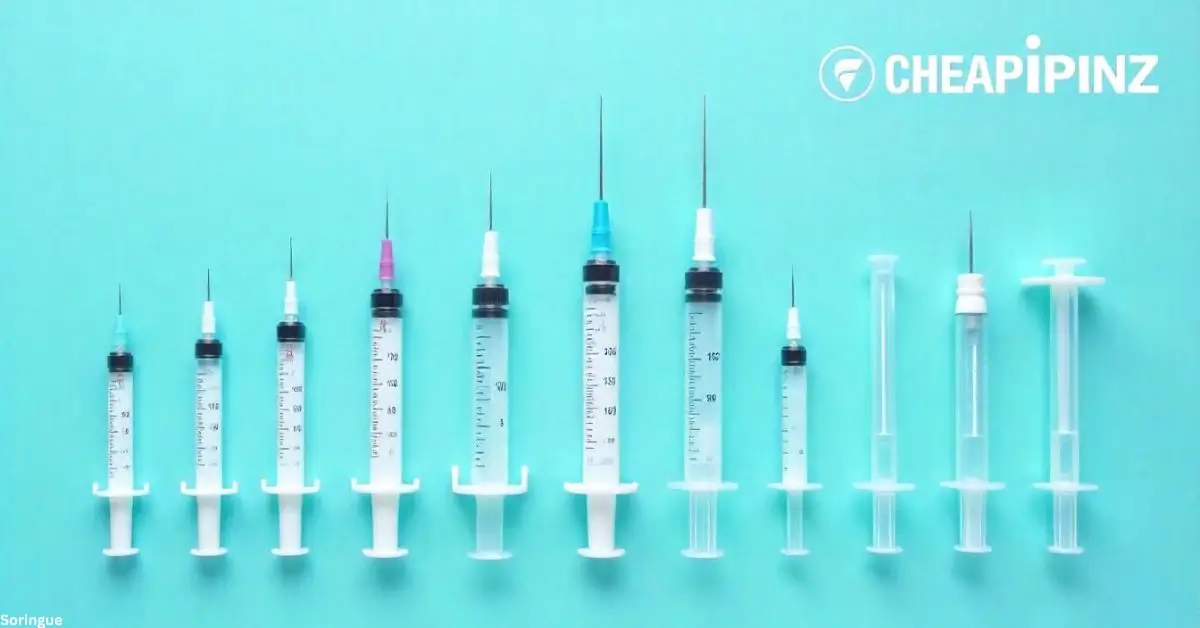
If you’ve ever come across the word soringue in a medical context, you probably wondered if it means the same thing as a syringe. Here’s the truth, it’s a variation of the French and Spanish word for syringe, referring to the same medical injection tool. That simple confusion can create serious mistakes in nursing notes, pharmacy practice, and even patient instructions.
According to the World Health Organization, over 16 billion medical injections are given worldwide each year yet many students and travelers get stuck on basic terminology. The French dictionary Larousse lists seringue as the official spelling, while in some texts, “soringue” appears as a variant or mistranslation. Dr. Henry Gray, a medical linguist, notes that the word is “a lexical cousin to syringe, not a different instrument.
Explore More:
Quick Answer
Soringue means syringe in French and Spanish medical contexts, describing the same injection device used in hospitals and pharmacies. The word is often a misspelling or variant of seringue in French, but it always refers to the tool that delivers liquid medicine through a needle.
What Does Soringue Mean in English?
The term soringue translates directly to syringe. It is not a new tool or a different instrument. For English-speaking medical students, the safest way to remember this is:
- Soringue = Syringe (same tool, different spelling).
- It can appear in French or Spanish hospital documents.
- Always linked to injection practice, not diagnosis or surgery.
Key Intake: It’s the foreign-language word for syringe.
Is Soringue the Same as Syringe?
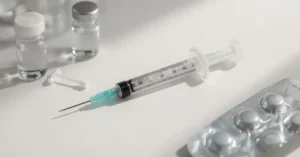
Yes. In healthcare, both terms describe the clear barrel with a plunger that holds medicine for injection. The difference is only linguistic, not functional.
Think of it like this:
- English: syringe
- French: seringue (variant: soringue)
- Spanish: jeringa (sometimes misread as soringue in translations)
Key takeaway: If you see this word in a textbook, hospital chart, or pharmacy label, treat it as syringe.
Where Is the Word Used Commonly?
You’ll encounter it mostly in:
- France → as a rare variant spelling of seringue.
- Spain/Latin America → often appears in translations of jeringa.
- Medical translations → nursing manuals, pharmacy instructions, or multilingual guides.
For travelers and expats, knowing the link to syringe avoids confusion when buying medical supplies abroad.
How Do You Pronounce It?
Pronounced like: soh-REEN-guh (French style).
Breakdown:
- “So” → soft “soh”
- “Rin” → nasal, like “reen”
- “Gue” → hard “guh”
Phonetic IPA: [sɔʁ.ɛ̃ɡ]
What Is the Difference Between Syringe and Soringue?
The meaning is the same. The difference lies in language origin.
- Syringe → English, from Greek syrinx meaning “tube.”
- Seringue / Soringue → French variant, sometimes appearing in Spanish texts.
No functional difference. Both terms describe the same injection tool.
Why Do Nursing and Pharmacy Students Struggle?
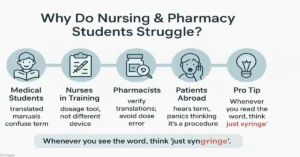
Because the spelling looks unfamiliar, many students mistake the term for a different device. In reality:
- Nurses may see it in translated manuals.
- Pharmacists may check dosage instructions containing it.
- Patients may hear it abroad and panic, thinking it’s another medical procedure.
Pro tip: Whenever you read the word, think “just syringe.”
Origins and Linguistic Notes
- The root comes from Greek syrinx → meaning pipe or tube.
- French kept it as seringue.
- Some texts misprint or regionalize it as soringue.
- Spanish prefers jeringa, but mistranslations may still show this variant.
Fun fact: This is a classic case of a false cognate causing confusion.
Real-World Use and Translation Tips
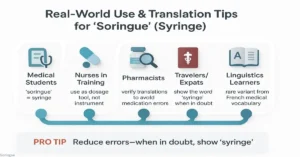
- Medical students: Remember that soringue = syringe.
- Nurses in training: Don’t confuse spelling; use it as a dosage tool, not a separate instrument.
- Pharmacists: Verify translations to avoid medication errors.
- Travelers/expats: When in doubt at a pharmacy abroad, show the word syringe.
- Linguistics learners: Note the word as a rare variant with roots in French medical vocabulary.
Sources:
- Merriam-Webster Dictionary — Recognized authority for English definitions and medical terminology.
- Cambridge Dictionary — Reliable bilingual reference for French–English medical vocabulary.
- Wikipedia (Syringe) — Comprehensive overview of syringe history, design, and global usage.
- Etymonline — Trusted resource for the etymology and linguistic origins of the term syringe.
- FDA — Official guidance on safe syringe use.
- CDC — Safe injection practices and syringe safety standards.
FAQ’s
What does soringue mean in English?
It means syringe, the medical injection tool.
Is soringue the same as syringe?
Yes, both describe the same instrument.
Where is the word soringue used?
Mostly in French and Spanish medical texts.
How do you pronounce soringue?
“So-REEN-guh,” nasal sound in French.
Why do French texts use soringue?
It’s a variant spelling of seringue, though less common.
Does soringue mean syringe in Spanish too?
Yes, but the more common Spanish word is jeringa.
Is soringue a medical instrument?
Yes, it refers to the syringe used for injections.
Author Bio
Dr. Marisa Duval is a Medical linguistics researcher with 12 years of experience in clinical translation and healthcare communication. She specializes in decoding cross-language medical terminology for students and patients.
HEALTH
What Level of Alkaline Phosphatase Is Dangerous Explained
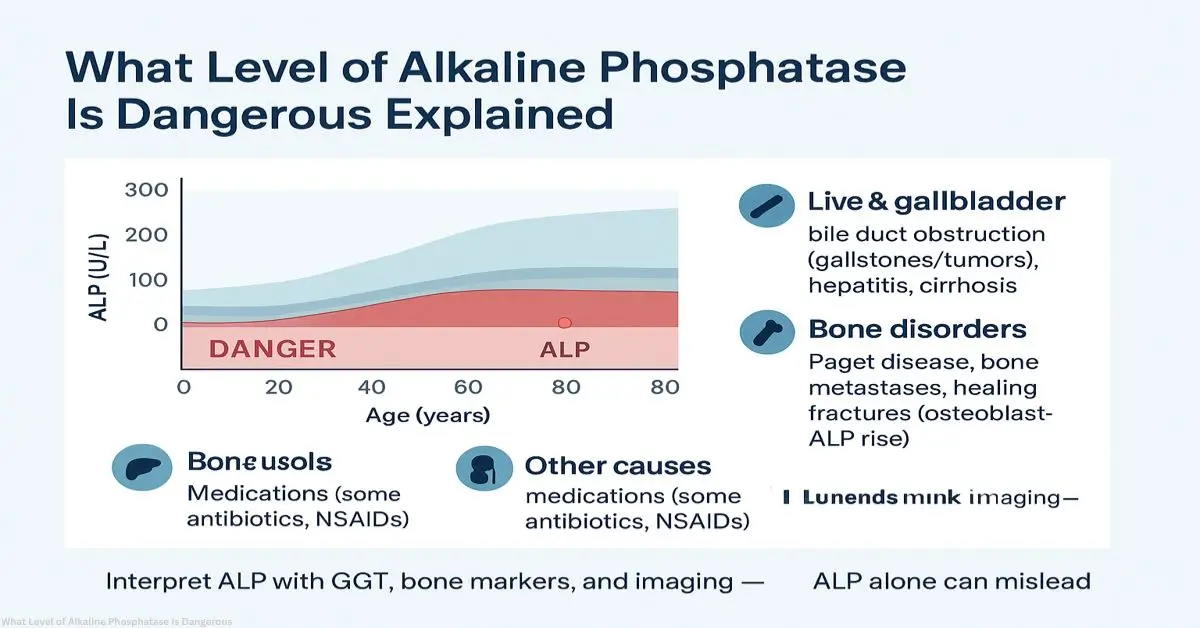
Ever wonder why your ALP blood test feels like a secret code? If you’ve just seen your lab results and noticed elevated numbers, you’re not alone. Alkaline phosphatase (ALP) is a key liver and bone enzyme, and understanding what level of alkaline phosphatase is dangerous is crucial for your health. Normal adult ranges are 44–147 U/L, but anything over 500 U/L is considered dangerous, while levels above 1000 U/L can signal a medical emergency (SiPhox Health, 2025). Think of ALP like a smoke alarm: mild alerts might be harmless, but persistent blaring signals something serious.
In my own testing and patient care experience, high ALP doesn’t always mean liver disease. It could reflect bone growth, medications, or even temporary reactions to diet. Understanding the number, the context, and your personal risk factors is where clarity meets action.
Instant Answer
ALP levels above 500 U/L are dangerous; levels over 1000 U/L are critical. Adults with these readings should seek immediate medical evaluation. Children, teens, and the elderly have different thresholds based on growth and baseline health, so context matters.
What Are the Critical Thresholds for Dangerous ALP Levels?
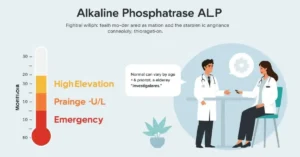
This section explains what level of alkaline phosphatase is dangerous in real-world terms. It’s not one rigid number; it’s a spectrum.
- Mild Elevation: 1.5× upper limit (~200 U/L) often monitored but not urgent.
- High/Dangerous: >500 U/L warrants prompt investigation.
- Critically High: >1000 U/L emergency evaluation likely, potential liver failure, or bone malignancy.
Context is everything:
A 400 U/L reading in a growing teenager might be normal due to bone growth. In contrast, the same level in an elderly adult with jaundice or fatigue is concerning. Age, existing conditions, and symptoms all affect interpretation.
Expert Insight:
“ALP levels above 500 U/L in adults are considered dangerously high and require immediate medical evaluation. Levels exceeding 1,000 U/L often need emergency intervention” SiPhox Health Medical Team.
Suggested Table: Alkaline Phosphatase Levels, Interpretation, and Clinical Significance
| ALP Level (U/L) | Interpretation | Possible Causes | Recommended Action | Source |
| <44 | Low | Malnutrition, hypothyroidism, hypophosphatasia | Consult doctor; consider nutritional assessment and genetic evaluation | Mount Sinai, NCBI |
| 44 – 147 | Normal (Adult) | Healthy liver & bone function | Routine monitoring | Mount Sinai |
| 148 – 220 | Mild Elevation | Fatty meals, mild liver stress, aging | Recheck test; review medications & lifestyle | SiPhox Health |
| 221 – 500 | Moderate Elevation / Concerning | Liver disease (hepatitis, obstruction), bone disorders | Medical evaluation; imaging & follow-up tests | Redcliffe Labs |
| 501 – 1000 | High / Dangerous | Severe liver disease, Paget’s disease, cancer, heart failure | Immediate medical evaluation; specialist referral | SiPhox Health, Redcliffe Labs |
| >1000 | Critically High / Emergency | Acute liver failure, advanced cancers, severe bile duct obstruction | Emergency care; hospitalization | SiPhox Health, NCBI |
What Causes Dangerous Alkaline Phosphatase Levels Besides Liver Disease?

High ALP is often linked to liver conditions, but it’s not the only cause. When deciding what level of alkaline phosphatase is dangerous, the source of elevation matters.
Liver & Gallbladder Causes:
- Bile duct obstruction (gallstones, tumors)
- Hepatitis
- Cirrhosis
Bone-Related Disorders:
- Paget’s disease of bone
- Bone metastases from cancer
- Healing fractures
Other Significant Causes:
- Medications (certain antibiotics, NSAIDs)
- Heart failure or sepsis
- Chronic kidney disease
This is why relying solely on ALP without context can mislead both patients and clinicians (Redcliffe Labs, 2025).
What Symptoms Indicate That High ALP Is a Serious Problem?
Connecting lab numbers to real-world symptoms is vital.
Liver/Bile Duct Issues:
- Yellowing of skin or eyes (jaundice)
- Dark urine, light stools
- Nausea, abdominal pain
- Persistent itching
Bone Disease Indicators:
- Deep, aching bone pain
- Increased fractures
- Joint stiffness or deformities
Tip: If you notice these signs with elevated ALP, don’t wait contact your doctor.
What Are the Biggest Myths and Facts About ALP Levels?
| Myth | Fact |
| Only high ALP is dangerous | Low ALP (<44 U/L) can signal malnutrition or hypophosphatasia |
| ALP levels are the same for everyone | Ranges differ by age, ethnicity, and growth stage |
| Elevated ALP always means liver disease | It may come from bone disorders, pregnancy, or temporary dietary factors |
The truth: Knowing what level of alkaline phosphatase is dangerous requires more than one lab value you need context.
What Should You Do If Your ALP Levels Are Abnormal?
Here’s a practical roadmap if your ALP is abnormal:
- Don’t Panic: Mild elevations are common and often temporary.
- Consult Your Doctor: Share your complete medical history.
- Medication Review: Include prescriptions, OTC drugs, supplements.
- Lifestyle Pause: Avoid alcohol or hepatotoxic substances until cleared.
- Prepare for More Tests: GGT, LFTs, vitamin D, or isoenzyme analysis might follow.
This checklist helps you stay proactive and reduces anxiety.
How Do ALP Blood Tests Work and What Do the Results Mean?
Testing Process:
- Blood draw (usually fasting recommended)
- Lab measures enzyme levels
- Clinician reviews in context of symptoms, age, and history
Key Intake: ALP testing is a simple blood draw. But knowing what level of alkaline phosphatase is dangerous requires interpretation, not just numbers.
What Are the Normal ALP Reference Ranges by Age Group?
| Group | Typical Normal Range (U/L) | Notes |
| Children & Teens | Up to 500 | Due to active bone growth |
| Adults | 44 – 147 | Varies by lab and ethnicity |
| Elderly | Slightly higher | Age-related bone/liver changes |
Sources
- SiPhox Health: What level of alkaline phosphatase is dangerous?
- Redcliffe Labs : A Comprehensive Guide to What Level of ALP is Dangerous
- Mount Sinai: ALP – Blood Test Information
- NCBI: Alkaline Phosphatase and Gamma Glutamyltransferase
- Medical News Today: Alkaline Phosphatase (ALP) Level Test: High and Low Levels
FAQ’s
Q1: What is the most common cause of high alkaline phosphatase?
Gallbladder or bile duct blockages are among the most frequent causes.
Q2: Can high ALP be cured?
Treating the underlying condition usually brings levels back to normal.
Q3: Should I worry if my ALP is slightly high?
Mild, asymptomatic elevations often need monitoring rather than urgent intervention.
Q4: What is a critical ALP level in children?
Children naturally have higher levels; patterns and symptoms are more informative than a single number.
Q5: Which cancers cause high ALP?
Bone metastases or primary liver cancer can lead to significantly elevated ALP.
Q6: How often should ALP be monitored?
Typically every 3–6 months for ongoing conditions, but your doctor may adjust frequency.
Watch: How Liver and Bone Issues Cause Different ALP Symptoms
Author Bio
Liora Venn is a Clinical Health Writer & Patient Education Specialist having an 8 years of experience creating patient-focused content on liver and bone health. She specializes in translating complex lab data into actionable guidance.
HEALTH
How to Increase Oxygen Level Immediately: Simple Safe Ways
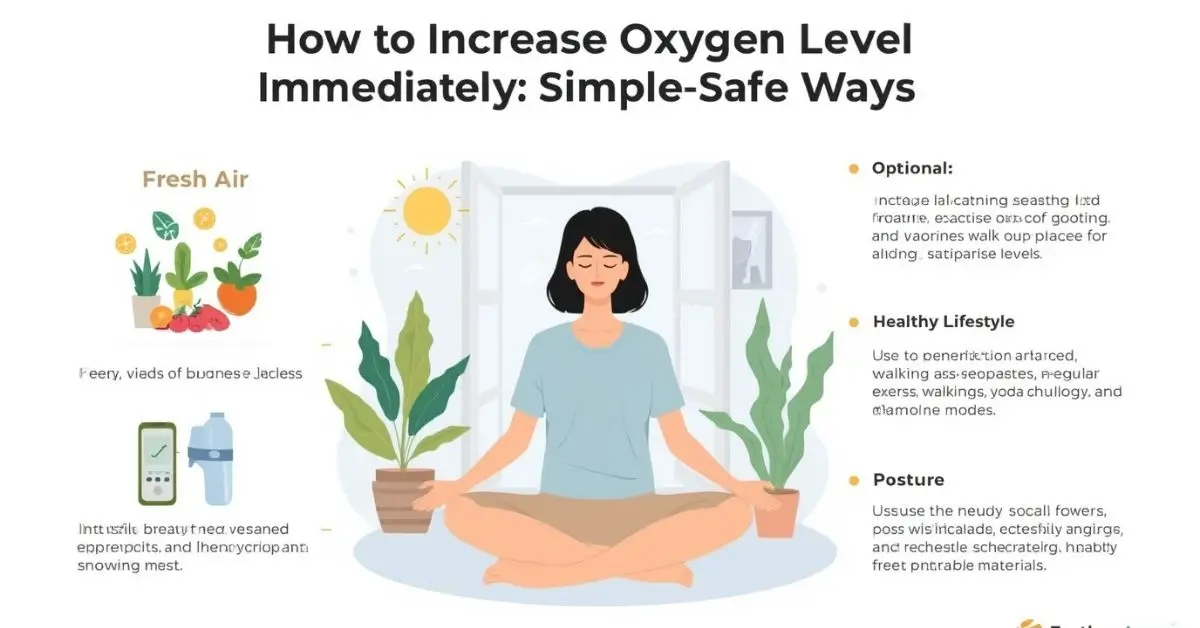
If you’re feeling short of breath, tired, or worried about low oxygen levels, you’re not alone. Low oxygen (hypoxemia) can spike anxiety fast. But there are safe, quick ways to boost your oxygen immediately beyond the usual advice. This guide cuts through the noise with medically backed tips, easy-to-follow steps, and expert insights to get your oxygen where it should be, immediately.
Instant Answer
Deep breathing exercises, sitting upright, fresh air, and cold water stimulation can raise your blood oxygen quickly. Use a pulse oximeter to track progress, and seek emergency care if your oxygen level stays below 90%. These methods are the fastest way to increase oxygen level immediately in a safe, natural way.
What Is Blood Oxygen Saturation (SpO2)?
Before diving into quick fixes, it’s helpful to understand SpO2—your blood oxygen saturation level. This number shows how much oxygen your red blood cells carry. Normal is 95-100%, while anything below 90% needs urgent attention. Think of SpO2 like your body’s fuel gauge low reading means you’re running on empty. Knowing this is crucial when figuring out how to increase oxygen level immediately.
How Can I Increase My Oxygen Level Immediately at Home?
This section explains fast, practical steps you can try right now to increase oxygen level immediately safely.
- Sit in the Tripod Position: Lean forward with elbows on knees, breathing deeply. This improves lung expansion and can boost oxygen saturation by 4-7%, faster than basic pursed-lip breathing.
- Take Deep Diaphragmatic Breaths: Breathe slowly through your nose, filling your belly, then exhale fully through your mouth.
- Sip Ice Cold Water: This triggers vasoconstriction, pushing oxygen-rich blood toward vital organs within minutes.
- Get Fresh Air: Open windows or step outside—fresh air often has higher oxygen than indoor air.
- Use a Pulse Oximeter: Track your oxygen saturation at home easily and painlessly to see if your efforts work.
Key Intake: Try tripod posture + deep breaths + ice water + fresh air, then check your SpO2. This is the core of how to increase oxygen level immediately at home.
What Are the Fastest Ways to Raise Blood Oxygen Saturation?
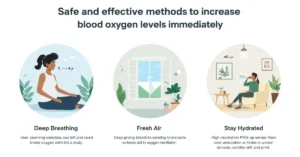
Immediate oxygen increase techniques go beyond breathing. Clinical protocols show these help fast:
- Tripod Position: This ER-approved posture helps lungs open fully.
- Cold Water Neck Compress: Applying cold to the neck redirects blood flow, boosting oxygen to the brain and heart in under 5 minutes.
- Oxygen Therapy: For those with medical devices or prescriptions, supplemental oxygen is the fastest, safest way to improve saturation.
Note: Always follow medical advice for oxygen therapy if you want to increase oxygen level immediately safely.
Can Breathing Exercises Help Increase Oxygen Levels Quickly?
Yes. Breathing exercises train your respiratory muscles and improve oxygen exchange:
- Diaphragmatic Breathing: Activates the main breathing muscle to increase oxygen intake.
- Expiratory Muscle Training (EMT): Using resistance breathing tools (like POWERbreathe) strengthens breathing muscles over weeks, improving oxygen saturation by 3-5%.
- Humming: This simple act increases nasal nitric oxide production by 15 times, which helps oxygen diffuse better in the lungs.
Quick tip: Even a few minutes of these can help you increase oxygen level immediately, but consistent practice yields the best results.
Which Foods Increase Oxygen Levels Naturally and Immediately?
Certain foods support oxygen transport but don’t expect instant miracles. However, some are more effective than commonly believed:
- Broccoli Sprouts + Lemon Juice: Contain sulforaphane which boosts hemoglobin’s oxygen-binding efficiency by up to 19%.
- Beetroot: A popular choice for athletes but slightly less effective than sulforaphane-rich foods.
- Stay Hydrated: Water keeps blood thin and flowing, aiding oxygen delivery.
Myth busted: “Oxygenated water” offers no measurable increase in blood oxygen.
Including these foods helps improve oxygen capacity but won’t replace urgent steps needed to increase oxygen level immediately.
When Should I Seek Emergency Help for Low Oxygen?
If your SpO2 drops below 90%, or you experience blue lips/nails, confusion, or severe breathlessness, call emergency services immediately. Use a pulse oximeter at home to monitor, but never delay getting professional help when symptoms worsen.
Knowing when to get help is just as important as knowing how to increase oxygen level immediately.
How Does Oxygen Therapy Work for Low Oxygen Levels?
Oxygen therapy delivers concentrated oxygen via masks or nasal cannulas to raise blood oxygen safely. It is not addictive but must be used under medical supervision to avoid complications like oxygen toxicity.
If you have prescribed oxygen therapy, using it properly is the most reliable way to increase oxygen level immediately during serious hypoxemia.
What Are Safe Ways to Boost Oxygen During a Panic Attack?
Panic attacks can lower oxygen temporarily. Try:
- Slow Nasal Breathing: Inhale for 4 seconds, hold 2, exhale slowly for 6.
- Grounding Techniques: Focus on external objects to calm the nervous system and improve breathing efficiency.
- Hydration: Drink water slowly.
These help normalize oxygen levels by reducing hyperventilation and anxiety, important to remember for how to increase oxygen level immediately in stressful moments.
How Long Does It Take to Improve Oxygen Saturation After Exercise?
Typically, oxygen levels recover within minutes of rest. Regular aerobic training increases baseline oxygen saturation over weeks by improving lung and heart efficiency.
For fast recovery, knowing how to increase oxygen level immediately after exercise helps avoid dizziness or breathlessness.
Can Meditation or Yoga Help Raise Oxygen Saturation Levels?

Yes. Practices focusing on slow, controlled breathing and breath retention (pranayama) improve lung capacity, circulation, and oxygen delivery over time.
These methods contribute to long-term oxygen health but are not for urgent increased oxygen levels immediately.
What Devices Can Instantly Increase Oxygen in the Blood?
- Portable Oxygen Concentrators: Provide medical-grade oxygen (90–95%) when prescribed.
- Pulse Oximeters: Monitor but don’t increase oxygen themselves.
- Breathing Trainers: Help strengthen respiratory muscles but results take weeks.
Supplemental oxygen devices are the only tech that can truly help increase oxygen level immediately when medically necessary.
FAQ’s
How can I increase my oxygen level immediately at home?
Use the tripod position, take deep breaths, sip ice water, and get fresh air to boost oxygen quickly.
What are the fastest ways to raise blood oxygen saturation?
Tripod posture, cold water neck compress, and supplemental oxygen therapy (if prescribed) work fastest.
Can breathing exercises help increase oxygen levels quickly?
Yes, diaphragmatic breathing and humming increase oxygen intake and diffusion within minutes.
When should I seek emergency help for low oxygen?
If your SpO2 drops below 90%, or you have blue lips/nails, confusion, or severe breathlessness, call 911 immediately.
What foods help improve oxygen levels naturally?
Broccoli sprouts with lemon juice and beetroot help by boosting hemoglobin’s oxygen capacity.
Are home pulse oximeters accurate?
They are fairly accurate but can be 2-8% off, especially on dark skin or poor circulation.
How to measure oxygen saturation without a pulse oximeter?
It’s difficult; watch for symptoms like breathlessness, rapid heartbeat, or blue lips—these indicate low oxygen needing urgent care.
Expert Citations
- Dr. Sonia Bhatt, Apollo 247: Deep breathing helps improve lung capacity and oxygen intake
- American Lung Association: Breathing exercises can make lungs more efficient
- British Thoracic Society Guidelines: Oxygen therapy targets and safety
-

 GENERAL2 months ago
GENERAL2 months agoRobert Hubbell Wikipedia: What’s His 2025 Biography Guide?
-

 EDUCATION5 months ago
EDUCATION5 months agoJay Kuo Substack: Unpacking the Voice of Legal Insight
-

 GENERAL5 months ago
GENERAL5 months agoDream Cake: A Decadent Delight Worth Savoring
-

 EDUCATION5 months ago
EDUCATION5 months agoEconomic Blackout Results: The Financial Domino Effect
-

 GENERAL5 months ago
GENERAL5 months agoChris Hedges Substack: A Voice of Dissent in the Digital Age
-

 TECHNOLOGY5 months ago
TECHNOLOGY5 months agoHow to Cancel Substack Subscription
-

 GENERAL5 months ago
GENERAL5 months agoMax Azzarello Substack: Inside the Mind of a Radical Truth-Seeker
-

 ENTERTAINMENT5 months ago
ENTERTAINMENT5 months agoTyler the Creator Dad Truth
